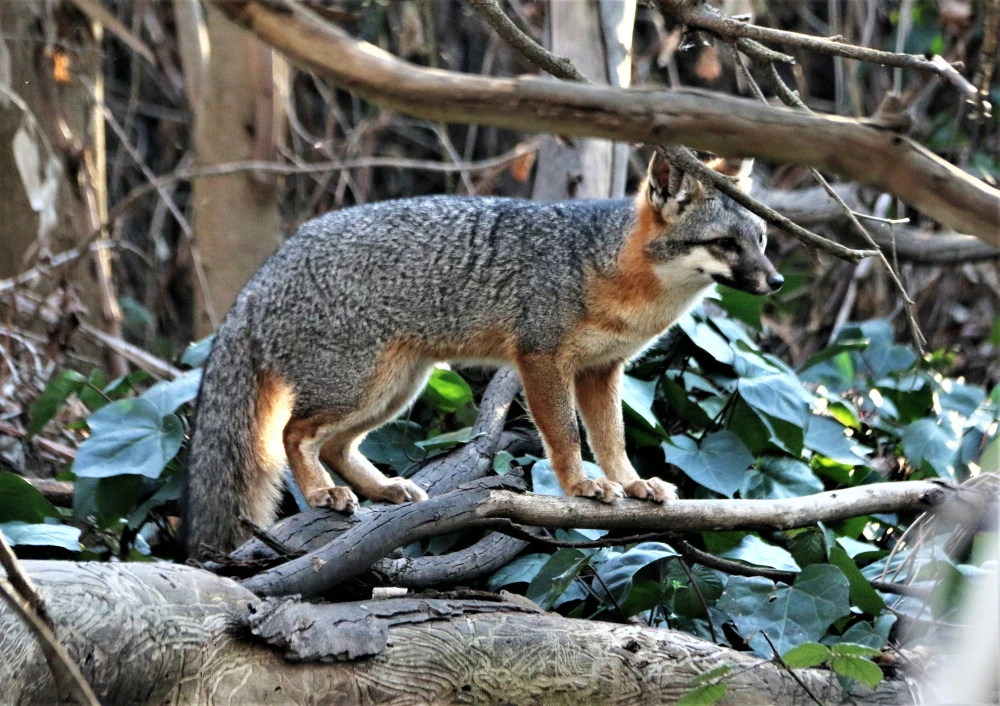Changes in Foxland
by William C. Leikam
President, CEO & Co-founder, Urban Wildlife Research Project
Nothing is constant in foxland. If you recall, last month the issue was with the tagged female fox Flop who had trespassed into the foxes’ Big Eyes and Laimos territory. They tried to drive her out of their region. Over this past month there have been some basic changes in their behavior. For instance, from the log of Wednesday, October 9, 2019: This afternoon was quite eventful. Johanna and I were near the channel when we saw Laimos over on the fallen eucalyptus tree. He went up one level, curled up on the big branch and went to sleep. Meanwhile, the female Flop entered the scene. At about the same time, back under the fallen trees we spotted the female Big Eyes. With Flop there I thought that there might be a fight. Big Eyes was back along Hummer Trail. She arched her tail, her back raised, her legs extended announcing that she was ready to fight if necessary.
She walked along Hummer Trail headed directly at Flop. She didn’t move. They remained about 15 feet apart just watching and listening to each other. Then, Big Eyes walked back toward the junction with Blackberry Trail where she lay down and watched Flop. Flop did the same right at the juncture of Hummer Trail. They were about 20 feet apart. After some time, it became apparent that the two of them would not fight. Flop came out into the open, crossed and came up close to us, then walked back over to the junction with Hummer Trail. After about five minutes, Flop went down into the brush under the fallen eucalyptus tree while Big Eyes went back toward camera #4 along Blackberry Trail.
This was our first concrete observance that the fighting had stopped, we thought, at least for a while. During the next ten days the foxes tolerated each other’s presence. For instance, one evening on trail camera #3, Laimos and Big eyes foraged along the edge of the channel near the retaining wall. Ten seconds into the 30 second clip, from off on the left edge of the frame, Flop came into the picture. At first Big Eyes stared at her, but then went back to foraging. This continued through three clips where Laimos paid no attention and the three of them foraged side-by-side until Laimos trotted off toward the ditch, followed maybe 20 seconds later by Big Eyes.
On October 11, 2019 I finished with camera #1 at the ditch and approached camera #2 at channel marker #17. Big Eyes was over in the dead grass and her mate Laimos came from the brush and trotted to the concrete channel. At about the same time, maybe 5 seconds later, Flop came from down the channel, went on over to where Laimos and Big Eyes stood and she – Flop – approached Laimos and submissively greeted him, then she backed off. Laimos went back over to where Big Eyes stood and snapped at her and growled. (I wonder what that meant.)
Flop’s gesture toward Laimos is highly meaningful in that she clearly shows that she respects him as the alpha male of the region. This was a peacemaking gesture of the highest order. As the month proceeded, however, right around October 24th it occurred to me that we hadn’t seen Flop on camera nor live over the past several days. Most of the time she had been in the clips of the foxes or showed up live along the channel, but from that date on we have not seen Flop.
I have seen this pattern of behavior in other foxes, i.e. unattached, roaming fox enters a claimed territory, remains for a time, then leaves. Sometimes they are never seen again, but then at other times they return and take up a kind of uneasy residency.
Gray Foxes General Health
This pair is young, most likely first-year dispersals. They appear to be vibrant and healthy although there have been a couple of scat deposits that were soft like diarrhea. The gray fox Flop seems to be healthy too.
Total Numbers of Gray Foxes in the Palo Alto Baylands Nature Preserve
Section III
Gray Fox, Baylands Goals
Within the permit that allows the Urban Wildlife Research Project to conduct its study of the behavior of the gray fox at the Palo Alto Baylands Nature Preserve, the objectives covered area:
- Monitoring of urban gray fox Denning sites in Palo Alto Baylands.
This is being accomplished during the period when the gray foxes use a den site. It is one of the prime locations for gathering most of the behavioral data of the litter and for adults alike.
- Assessment of status and population trends of Baylands urban gray foxes
Since January 2019 a pair of resident gray foxes have claimed territory at the Palo Alto Baylands Nature Preserve.
- Identification of habitat features that promote the presence of urban gray foxes
After considering this and talking with people who know how to restore habitats, we need to assess what kinds of plants, including the Alkaline Salt Bush, would grow best along the edge of the saltwater channel and alongside the marsh. We need to grow a permanent habitat that contains the corridors and plant it as soon as possible. We’ll keep an eye on this as this is a critical link between the southern region of the Baylands and the northern region.
- Assessment of reproductive success and identification of factors that promote successful reproduction
Open up the pinch-point along Matadero Creek by developing thickets that link one area to another, instead of the present “islands”.
- Identification and assessment of possible dispersal travel routes.
Presently there can only be guesses as to dispersal travel routes. We intend to make this important question much more concrete when we attain our collaring/take/capture permit from the Department of Fish & Wildlife.




